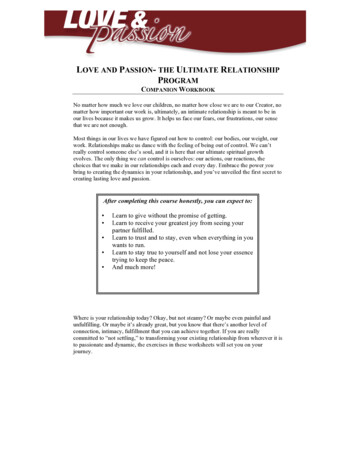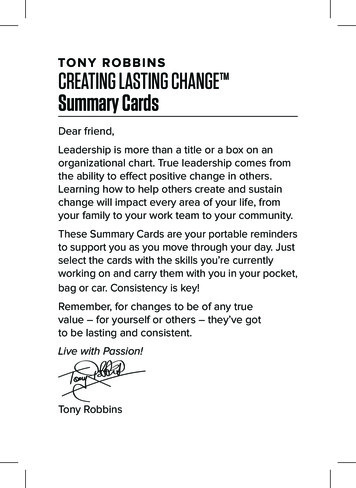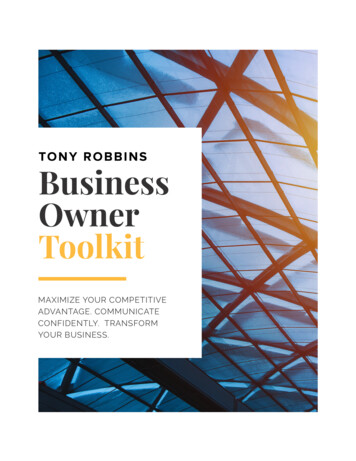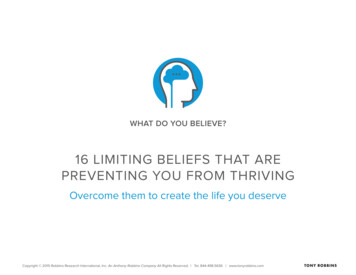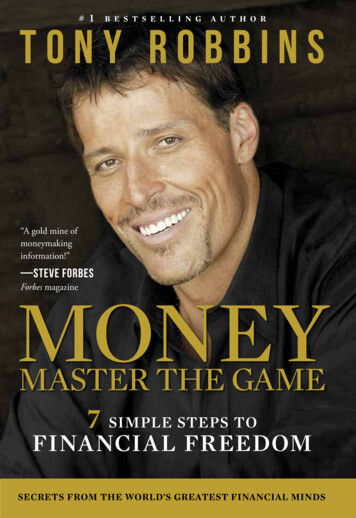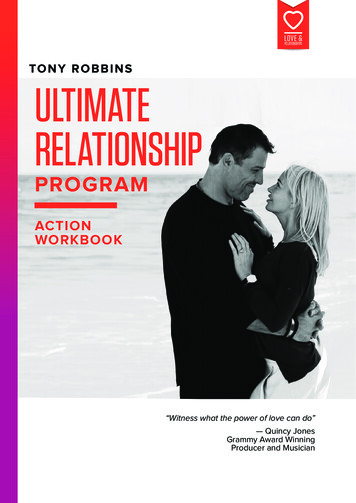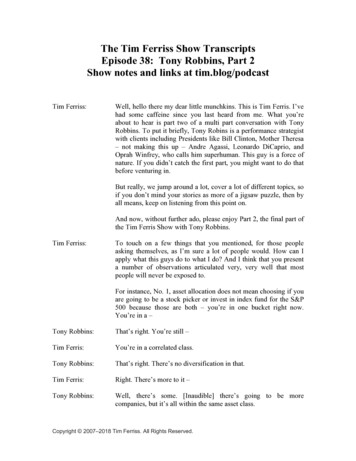
Transcription
The Tim Ferriss Show TranscriptsEpisode 38: Tony Robbins, Part 2Show notes and links at tim.blog/podcastTim Ferriss:Well, hello there my dear little munchkins. This is Tim Ferris. I’vehad some caffeine since you last heard from me. What you’reabout to hear is part two of a multi part conversation with TonyRobbins. To put it briefly, Tony Robins is a performance strategistwith clients including Presidents like Bill Clinton, Mother Theresa– not making this up – Andre Agassi, Leonardo DiCaprio, andOprah Winfrey, who calls him superhuman. This guy is a force ofnature. If you didn’t catch the first part, you might want to do thatbefore venturing in.But really, we jump around a lot, cover a lot of different topics, soif you don’t mind your stories as more of a jigsaw puzzle, then byall means, keep on listening from this point on.And now, without further ado, please enjoy Part 2, the final part ofthe Tim Ferris Show with Tony Robbins.Tim Ferriss:To touch on a few things that you mentioned, for those peopleasking themselves, as I’m sure a lot of people would. How can Iapply what this guys do to what I do? And I think that you presenta number of observations articulated very, very well that mostpeople will never be exposed to.For instance, No. 1, asset allocation does not mean choosing if youare going to be a stock picker or invest in index fund for the S&P500 because those are both – you’re in one bucket right now.You’re in a –Tony Robbins:That’s right. You’re still –Tim Ferris:You’re in a correlated class.Tony Robbins:That’s right. There’s no diversification in that.Tim Ferris:Right. There’s more to it –Tony Robbins:Well, there’s some. [Inaudible] there’s going to be morecompanies, but it’s all within the same asset class.Copyright 2007–2018 Tim Ferriss. All Rights Reserved.
Tim Ferris:Yeah, and the other thing is that there are ways to look at theproblem that are not obvious right off the bat. For instance, youmentioned something that’s so simple, but a lot of people miss. Ifyou invest, and you lost 50 percent, you have to now have 100percent gain to get back to break even. Put another way, and this isalso straight from the book, let’s just say – I think it was investingover – it was either five or ten years. The exact number is in thebook.You had invested in the stock market through a – let’s just call itoff the shelf mutual fund that charges typical fees, and the marketmoves up and down, up and down, up and down. At the end of thatperiod of time, you’re back at the same market levels. You wouldthink if you put in 100,000.00 you’d have 100,000.00 at the endof that period of time, and it ends up that you’re, what, 47 percentdown?Tony Robbins:Yeah.Tim Ferris:Something obscene.Tony Robbins:It’s the idea average rates of return. A lot of people look at whatthey’ve invested, and their broker or whoever represents them willshow them the portfolio and go, “Look, you started here. You wentup 50 percent, you down 50, but you went up 50, and you wentdown 50, so your average rate of return is zero. But if I put realdollars in there, 100,000.00, and you go up 50 or 150, you godown 50, you’re at 75. You go up 50, oops, and then you go down,and you end up at 37,000.00 instead of 100,000.00 because yourprinciple is moving up and down. There are all these ways wecould do it. The biggest one – the biggest lie – in the book, I walkyou through seven steps.One of those steps is, frankly, you got to do what most of us guysthat probably do the listing on your team already do, and that is,you’ve got to become and investor – you’ve got to be an owner,not a consumer, right? The way to do that, frankly, we all know,but very few people do, and that’s you take a percentage, you lockit down, and you never see it. It’s automated, and you put it asidefor investment, and that just occurs. I’ve showed the people someof the tools that Nobel Prize winners have come up with. If yousay, “I have no money,” you could invest more for tomorrow bycommitting when you get a raise or when your company gets to thenext level. You automatically have that percentage go there, so it’smoney you’ve never seen. It’s taking away money from you, soyou’re willing to commit to it, right?Copyright 2007–2018 Tim Ferriss. All Rights Reserved.
Tim Ferris:And there are ways to automate that.Tony Robbins:Totally automated, which is fantastic. They took a group of bluecollar workers who couldn’t save more than three percent, and theyshowed in 12 years they had them up to 16 percent with absolutelyno sense of loss because once – they show this with example. Abehaviorist showed me that if you give that monkey an apple, theygo crazy, and if you give them two apples, and they go crazy. Ifyou take one of two apples back, they’re angry as hell. They stillhave the same first apple.What happens is if you don’t give them that second apple, but itgets invested for them that changes your world. You don’t feel asense of loss, there’s no drop, and yet, you set yourself up saving15, 16, and 17 percent in a totally different world than 3 ornothing, obviously. Second piece that I brought this up for isyou’ve got to – it’s great to get in the game, but oh, my god, don’tget in the game until you understand the rules, until you’re andinsider, and so I go through the nine biggest lies. They’reinvestment lies. They’re Wall Street lies – however you want tocall them, but they’re marketed lies. There’s a reason you believethem.Tim Ferris:Very heavily marketed lies.Tony Robbins:Very heavily marketed, to the advantage, right? One of those isthis idea that they’re going to beat the market. Here are the realfacts: 96 percent – check it out – 96 percent of all mutual funds, ina ten year period, will never even match the market. Now, you’repaying a premium. You could’ve owned an index that costed you20 basis points at Vanguard or 14 basis points depending whatindex you’re doing. Instead, you’re paying, they say, one percent.You ask people [inaudible] one percent. In reality, if you gothrough –Forbes has shown the average mutual fund when you put all fees in– if you read the perspectives, and there’s all these 21 B trading –all these things that don’t – they don’t call for these very often, butthey are money out of your pocket. The average is 3.1 percent.Now, when you do that, here’s the problem. No. 1, only fourpercent – what’s your chance of picking the four percent of mutualfunds that are going to be succeed. If you go for Morningstar,you’re screwed because I can show you statistically. Morningstar’sown statistics have shown a ten year period of 250 people thatCopyright 2007–2018 Tim Ferriss. All Rights Reserved.
made it to five star Morningstar, four are left. Doesn’t work thatway, right?If you could pick the four percent, if you were magically able to dothat, you could do all right, but the four percent’s always changing.Your chances of picking the right mutual fund are 96 percentagainst you, and the average person’s 401k at work – they don’tknow how to evaluate this. They try and pick it, so they’rescrewed. And then you get poor performance, and you paysomewhere between 10 and 30 times more for the same investmentyou could’ve got for 10 to 30 times less. It’s like the ultimate insultto injury, and go, “Why does that mater?”Well, first, let me give you this. So people understand what 96percent means, they’re getting a 4 percent possible success rate. Ifyou and I played Black Jack – most people know how to play,right? Twenty-one. I get two face cards that are worth 20 points. Ifyou’re inner idiot says hit me when you’ve got two face cards togo to 21, you have an 8 percent chance of success. You have agreater chance of success there than you did if you’re going to findthe right mutual fund.Now, what’s your chance of success in getting financially freewhen – here’s what’s unbelievable. If I said to you, “Here’s aninvestment I want you to try, Tim. Here’s how it works. You putup all the money, you put up all the risk, and I will put up nomoney, and I will put up no risk, and if you win, I get up to 60percent of your entire growth of what you have over the lifetime ofyour investing. You put all money [inaudible], I take no risk, I putno money. And if you lose, you lose, but I don’t lose anything.That’s a deal that most people would say, “I’d never take in amillion years.” That’s the average mutual fund.For every one percent you pay, it’s 20 percent over the lifetime ofyour investments of growth because just like there’s compoundedgrowth, there are compounded fees. Vogel showed me, 60 percent– I’m saying, “Jack, how’s this possible? How could people bedoing this?” He goes, “Tony, it’s the 13 trillion lie, and it’s calledone thing, marketing.” I’ve been in the business 64 years. It makesme crazy, and people still do it. The vast majority of people puttheir money in a mutual fund. They [inaudible]. Now, he’s come tobe the largest mutual fund in the world with an index fund nowwith 2.5 trillion. Jack has been modified, but most of the smartmoney is there.Copyright 2007–2018 Tim Ferriss. All Rights Reserved.
It’s not the average person’s money that’s in the index today. I gothrough these lies, and what you don’t know in the financial worldwill hurt you, and the one you’re talking about is just the averagerate of return. You want to be seduced. When you look at the rateof return – Vogel said to me, he said, “Tony, whatever you seewhat the rate of return was and you’re trying to evaluate thatmutual fund based on its past performance, just to know thatnumber’s not accurate.” Dalbar did a great study – 20 year study.They found the average mutual fund owner of a 20 year period oftime made 2.5 percent in that.The at market was 9.7 percent. That ought to give you sense. Iwent to go do this book – and I won’t mention the person’s name. Igot all these incredible endorsements from everybody – NobelPrize winners, self-paid billionaires – all these guys. There’s aparticular person that I’m – a really good friend. I won’t mentionhis name, but it was ironic. He wrote me back and said, “Well, meteam’s read it, and they don’t think it’s really that special.” Ithought, well, I’m not insulted by that, but it doesn’t make sense tome. Then, I found out this person has six mutual funds [inaudible],so it’s like, “Okay, I get it, dude.”Tim Ferris:Yeah, don’t ask a barber if you need a haircut.Tony Robbins:That’s my fault. I’m so sorry. Never should’ve asked that question.Tim Ferris:Sorry about that one, yeah.Tony Robbins:He should’ve told me.Tim Ferris:I should point out to folks, also – some people are very mathphobic. Part of the reason I went to Princeton – it’s funny, I wasreading Carl Icahn’s story and how he was told he would never getinto any Ivy League schools, and he chose Princeton. Same thinghappened to me. I was told I would never get into a whole host ofschools because – and this is kind of like your mutual fund guy –humans respond to incentives.Tony Robbins:Yes.Tim Ferris:And this particular guidance counselor is incentivized for what? Tooptimize, to be able to say X percentage of students got into theirfirst choice school. So how do you do that most easily –Tony Robbins:Lower their expectations.Copyright 2007–2018 Tim Ferriss. All Rights Reserved.
Tim Ferris:Lower their expectations. I am intrinsically not someone with a lotof math background. Part of the reason I chose Princeton overother schools is because they didn’t have a math requirement, and Ithink for a lot of people listening, they may be like, “Oh, my god,percentages and compounding odds, it’s very overwhelming.”I think that part of the reason your book had to be as long as it is –and a book should be as long as it needs to be – is that if you wereto try to compress it into a 100 pages, it would be like watching a 3hour action movie, but getting a frame every 5 minutes. It wouldbe too much in too little space. But when people read the book –when I read the book – you’re leading people in a logicalprogression from building block to building block to buildingblock so that, by the end, people are very, very savvy.So people who might be thinking, “Oh, my god, this is really a lotfor me to absorb –,”Tony Robbins:I’m probably talking 100 miles an hour. In the book, I’m tellingyou stories, too, and I think the stories take it away so it’s notnumberage. You go, “Holy shit, if me and three of my friends allput aside the same amount of money, and we both get a sevenpercent return, but my buddy’s getting fees of three percent, myother buddy’s two, and I’m one, and all three of us put 1 millionin or 100,000.00,” however you want to do it, the person withthree percent of fees ends up with 65 percent less money, and theygot the same rate of return, they start with the same amount ofmoney over the same period of time.I think when you see that with real people’s lives, you start to go,“I don’t have to know the math. I just know one thing. Fees matter,and I’m going to cut those babies to absolute base.”Tim Ferris:Definitely. I’d love to talk – you brought it up a little bit earlier,Ray Dalio and asset allocation because this is something I’ve beenthinking about a lot considering that due to paper gains, I’d say Ihave a very, very, very high double digits of my entire network intech.It’s hard, unfortunately, to rebalance when you have a lot ofprivate stock that can’t be traded.Tony Robbins:Of course, been there.Tim Ferris:You know how it is. Dalio is someone I’ve been fascinated by forso long. Maybe you could talk about the all seasons and some ofCopyright 2007–2018 Tim Ferriss. All Rights Reserved.
the stuff that you chatted with him about as it relates to assetallocation.Tony Robbins:It might be helpful for people to take a second and give people hisbackground. Ray is not the guy you would think of as master of theuniverse. He comes from Queens. His dad was a jazz musician. Hismom was a homemaker, a really lovely lady. We went from a verylower mi
Tony Robbins: It’s the idea average rates of return. A lot of people look at what they’ve invested, and their broker or whoever represents them will show them the portfolio and go, “Look, you started here. You went up 50 percent, you down 50, but you went up 50, and you went down 50, so your average rate of return is zero. But if I put real dollars in there, 100,000.00, and you go up 50 .
